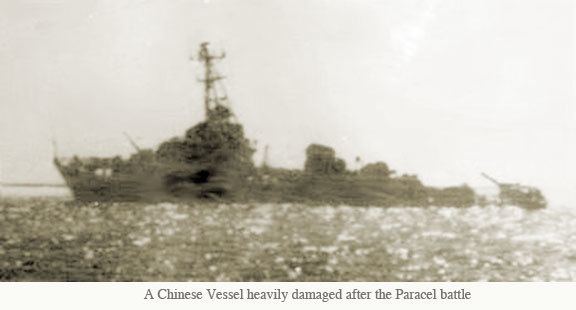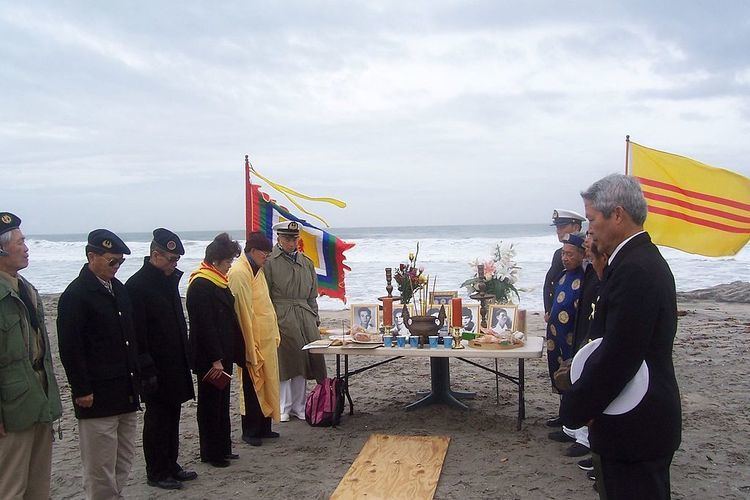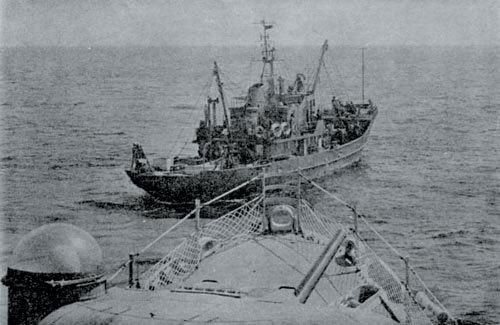Date 19 January 1974 | ||
 | ||
18 killedUnknown number injured4 minesweepers damaged Similar Johnson South Reef Skirmish, Sino‑Vietnamese War, Haiyang Shiyou 981 standoff, Easter Offensive, Operation Lam Son 719 | ||
Battle of the paracel islands
The Battle of the Paracel Islands was a military engagement between the naval forces of the People's Republic of China (PRC) and the Republic of Vietnam (South Vietnam) in the Paracel Islands on January 19, 1974. The battle was an attempt by the Republic of Vietnam Navy to expel the Chinese Navy from the vicinity.
Contents
- Battle of the paracel islands
- Background
- Prelude
- Balance of forces
- Military engagement
- Result
- Vietnamese casualties
- Chinese casualties
- Aftermath
- References

As a result of the battle, the PRC established de facto control over the Paracels. As part of its "nine-dash line" boundary policy in the South China Sea, the PRC continues to claim authority over the surrounding waters. This claim has been persistently contested by Vietnam, the Philippines, and many international observers.

Background

The Paracel Islands, called Xisha Islands (西沙群島; Xīshā Qúndǎo) in Chinese and Hoang Sa Islands (Quần Đảo Hoàng Sa) in Vietnamese, lie in the South China Sea lie approximately equidistant from the coastlines of the PRC and Vietnam (200 nautical miles). With no native population, the archipelago’s ownership has been in dispute since the early 20th century.

China first asserted sovereignty in the modern sense to the South China Sea’s islands when it formally objected to France’s efforts to incorporate them into French Indochina during the Sino-French War (1884–1885). Initially, France recognized Qing China's sovereignty over the Paracel and Spratly archipelagos, in exchange for Chinese recognition of Vietnam as a French territory. Chinese maps since then have consistently shown China’s claims, first as a solid and then as a dashed line. In 1932, one year after the Japanese Empire invaded northeast China, France formally claimed both the Paracel and Spratly Islands. China and Japan both protested. In 1933, France seized the Paracels and Spratlys, announced their annexation, formally included them in French Indochina. They built several weather stations on them, but they did not disturb the numerous Chinese fishermen found there. In 1938 Japan took the islands from France, garrisoned them, and built a submarine base at Itu Aba (now Taiping / 太平) Island. In 1941, the Japanese Empire made the Paracel and Spratly islands part of Taiwan, then under its rule.
In 1945, in accordance with the Cairo and Potsdam Declarations and with American help, the armed forces of the Republic of China government at Nanjing accepted the surrender of the Japanese garrisons in Taiwan, including the Paracel and Spratly Islands. Nanjing then declared both archipelagoes to be part of Guangdong Province. In 1946 it established garrisons on both Woody (now Yongxing / 永兴) Island in the Paracels and Taiping Island in the Spratlys. France promptly protested. The French tried but failed to dislodge Chinese nationalist troops from Yongxing Island (the only habitable island in the Paracels), but were able to establish a small camp on Pattle (now Shanhu / 珊瑚) Island in the southwestern part of the archipelago.
In 1950, after the Chinese nationalists were driven from Hainan by the People’s Liberation Army (PLA), they withdrew their garrisons in both the Paracels and Spratlys to Taiwan. In 1954 France ceased to be a factor when it accepted the independence of both South and North Vietnam and withdrew from Indochina.
In 1956 North Vietnam formally accepted that the Paracel and Spratly islands were historically Chinese. About the same time, the PLA reestablished a Chinese garrison on Yongxing Island in the Paracels, while the Republic of China (Taipei) stationed troops on Taiping Island in the Spratlys. That same year, however, South Vietnam reopened the abandoned French camp on Shanhu Island and announced it had annexed the Paracel archipelago as well as the Spratlys. To focus on its war with the North, South Vietnam by 1966 had reduced its presence on the Paracels to only a single weather observation garrison on Shanhu Island. The PLA made no attempt to remove this force.
Prelude
On January 16, 1974, six South Vietnamese Army officers and an American observer on the frigate Lý Thường Kiệt (HQ-16) were sent to the Paracels on an inspection tour. They discovered two Chinese “armored fishing trawlers” laying off Drummond Island to support a detachment of PLA troops who had occupied the island. Chinese soldiers were also observed around a bunker on nearby Duncan Island, with a landing ship moored on the beach and two additional Kronstad-class guided missile gunboats in the vicinity. This was promptly reported to Saigon, and several naval vessels were sent to confront the Chinese ships in the area. The South Vietnamese Navy frigate signaled the Chinese squadron to withdraw, and in return received the same demand. The rival forces shadowed each other overnight, but did not engage.
On January 17, about 30 South Vietnamese commandos waded ashore unopposed on Robert Island and removed the Chinese flag they found flying. Later, both sides received reinforcements. The frigate Trần Khánh Dư (HQ-4) joined the Lý Thường Kiệt (HQ-16), while two PLA Navy minesweepers (#274 and #271) joined the Chinese.
On January 18, the frigate Trần Bình Trọng (HQ-5) arrived carrying the commander of the South Vietnamese fleet, Colonel Hà Văn Ngạc. The corvette Nhật Tảo (HQ-10) also reached the islands, moving cautiously because it had only one functioning engine at the time.
Balance of forces
These four warships from the South Vietnam Navy would participate in the battle: the frigates, Trần Bình Trọng (HQ-05),[1] Lý Thường Kiệt (HQ-16),[2] and Trần Khánh Dư (HQ-04), [3], and the corvette Nhật Tảo (HQ-10).[4] A platoon of South Vietnamese naval commandos, an underwater demolition team, and a regular ARVN platoon were by now stationed on the islands.
China also had four warships present: the PLA Navy minesweepers # 271, #274, # 389 and # 396. These were old and small warships with an average length of 49 meters and width of 6 meters, and they had not been well-maintained. However, they were reinforced by two Kronstad-class submarine chasers (# 281 and # 282) by the end of the battle. In addition, two PLA marine battalions and an unknown number of irregular militia had been landed on the islands.
Although four ships were engaged on each side, the total displacements and weapons of the South Vietnamese ships were superior. The supporting and reinforcement forces of China’s PLA Navy did not take part in the battle.
Military engagement
In the early morning of January 19, 1974, South Vietnamese soldiers from the HQ-5 landed on Duncan Island and came under fire from Chinese troops. 3 Vietnamese soldiers were killed and more were injured. Finding themselves outnumbered, the Vietnamese ground forces withdrew by landing craft, but their small fleet drew close to the Chinese warships in a tense standoff.
At 10:24 a.m., the Vietnamese warships HQ-16 and HQ-10 opened fire on the Chinese warships. The HQ-4 and HQ-5 then joined in. The sea battle lasted about 40 minutes, with vessels on both sides taking damage. The smaller Chinese warships managed to maneuver into the blind spots of the main cannons on the Vietnamese warships and damaged all four Vietnamese ships, especially the Nhật Tảo (HQ-10), which could not retreat because her last working engine was disabled. The crew was ordered to abandon ship, but her captain, Lt. Commander Ngụy Văn Thà, remained on board and went down with his ship. The HQ-16, severely damaged by friendly fire from the HQ-5, was forced to retreat westwards. The HQ-4 and HQ-5 soon joined in the retreat.
The next day, Chinese aircraft from Hainan bombed the three islands, and an amphibious landing was made. The outnumbered Vietnamese garrison on the islands was forced to surrender, and the damaged navy ships retreated to Đà Nẵng.
During the battle, the Vietnamese fleet detected two more Chinese warships rushing to the area. China later acknowledged these were the Hainan-class submarine chasers #281 and #282. Despite South Vietnamese reports that at least one of their ships had been struck by a missile, the Chinese insisted what the Vietnamese saw were rocket-propelled grenades fired by the crew of #389 and that no missile-capable ships were present, and the Chinese ships closed in because they had no missiles. The South Vietnamese fleet also received warnings that U.S. Navy radar had detected additional Chinese guided missile frigates and aircraft on their way from Hainan.
South Vietnam requested assistance from the U.S. Seventh Fleet, but the request was denied.
Result
Following the battle, China gained control over all of the Paracel Islands. South Vietnam protested to the United Nations, but China, having veto power on the UN Security Council, blocked any efforts to bring it up. The remote islands had little value militarily, but diplomatically the projection of power was beneficial to China.
Vietnamese casualties
The South Vietnamese reported that the warship HQ-10 was sunk and the HQ-16 heavily damaged, while the HQ-5 and HQ-4 were both slightly damaged. 53 Vietnamese soldiers, including Captain Ngụy Văn Thà of HQ-10, were killed, and 16 were injured. On January 20, 1974, the Dutch tanker, Kopionella, found and rescued 23 survivors of the sunken HQ-10. On January 29, 1974, Vietnamese fishermen found 15 Vietnamese soldiers near Mũi Yến (Qui Nhơn) who had fought on Quang Hòa island and escaped in lifeboats.
After their successful amphibious assault on January 20, the Chinese held 48 prisoners, including an American advisor.[5] They were later released in Hong Kong through the Red Cross.
Chinese casualties
Chinese reports claimed that even though its ships had all been hit numerous times, none of them sank. China said its warships #271 and #396 had suffered speed-reducing damage to their engines, but both returned to port safely and were repaired. Warship #274 was damaged more extensively and had to stop at Yongxing Island for emergency repairs. It returned to Hainan under its own power the next day. Warship #389 was damaged the most by an engine room explosion. Its captain managed to run his ship aground and put out the fire with the help of the minesweepers. It was then towed back to base. China confirmed a total of 18 deaths among its forces.
According to the Chinese, the heavy smoke reported around #271 was not the result of damage but a deliberately laid smokescreen, although this is viewed with skepticism. The reluctance of the Chinese military to release further details or evidence left the issue in doubt. The Chinese squadron left the pursuit of the Vietnamese to their reinforcements.
Aftermath
A potential diplomatic crisis was averted when China released the American prisoner taken during the battle. Gerald Emil Kosh, 27, a former U.S. Army captain, was captured with the Vietnamese on Pattle Island. He was described as a “regional liaison officer” for the American embassy in Saigon on assignment with the South Vietnamese Navy. China released him from custody on January 31 without comment.
The leaders of North Vietnam gave a glimpse of their worsening relationship with China by conspicuously not congratulating their ally. An official communique issued by the Provisional Revolutionary Government of the Republic of South Vietnam mentioned only its desire for a peaceful and negotiated resolution for any local territorial dispute. In the wake of the battle, North Vietnamese Deputy Foreign Minister Nguyễn Cơ Thạch told the Hungarian ambassador to Hanoi that "there are many documents and data about that the islands in question are Vietnamese." Other North Vietnamese cadres told the Hungarian diplomats that in their view, the conflict between China and the Saigon regime was but a temporary one. However, they later said the issue would be a problem of the entire Vietnamese nation.
After the reunification of Vietnam in April 1975, the Socialist Republic of Vietnam publicly renewed its claim to the Paracels, and the dispute continues to this day. Hanoi has praised the South Vietnamese forces that took part in the battle.
